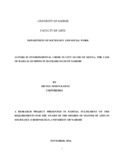| dc.description.abstract | Mathare slum is currently faced with a serious challenge of illegal dumping of waste. Waste poses a threat to public health and the environment if it is not stored, collected and disposed of properly. The main purpose of the study was therefore to investigate the actors in this illegal activity in the area. The study was guided by several objectives namely; To show the existing forms of waste management in Mathare slum; To identify the key actors in illegal dumping of waste in the area; To examine social and economic factors promoting this illegal activity and finally to determine the views of residents on how waste management should be improved. A survey was conducted, where 120 respondents from the area were issued with questionnaires. Six key informants were interviewed with in-depth interviews. Data was then collected and analyzed using quantitative and qualitative techniques.
The results of the study revealed that 27.2% of households disposed of their waste in gutters, streets, holes and in the nearby river. In addition, 14.9% burned waste outside their houses. Only a small proportion of the population used proper disposal methods. The study also showed that 63.3% of participants who lived near a dump site claimed it to be inefficient, citing that in many cases, it was overfilled and authorities normally delayed in emptying the dump site. It was also discovered that no respondent had received any training on proper waste disposal from the relevant public authority. However, all respondents were aware that illegal dumping of waste could contribute to disease causation. The study concluded that proper education of the public, the provision of communal trash bins, and frequent collection of waste by the municipal could help prevent exposing the residents to diseases in addition to significantly reducing cases of dumping in the area. Finally, the study recommends a further research to be carried out in other slums possibly in other counties to find out if the same results can be obtained. | en_US |



